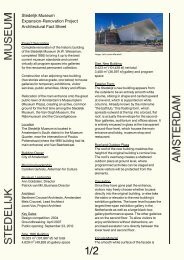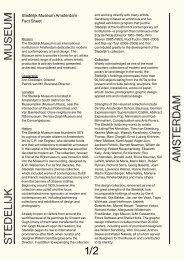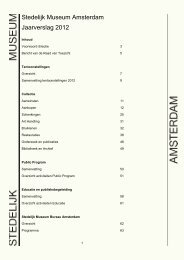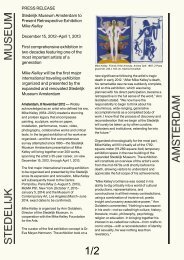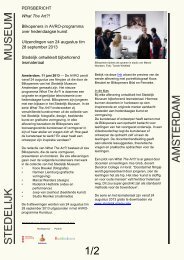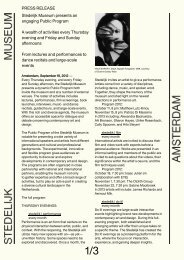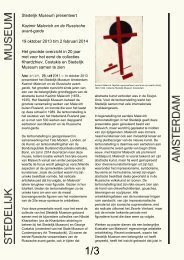Stedelijk Museum Annual Report 2012
Stedelijk Museum Annual Report 2012
Stedelijk Museum Annual Report 2012
Create successful ePaper yourself
Turn your PDF publications into a flip-book with our unique Google optimized e-Paper software.
<strong>Stedelijk</strong> <strong>Museum</strong> Bureau Amsterdam<br />
Overview<br />
In <strong>2012</strong>, <strong>Stedelijk</strong> <strong>Museum</strong> Bureau Amsterdam (SMBA) focused on Project 1975, a<br />
multi-year program exploring the postcolonial condition of our society and<br />
postcolonialism’s relevance for contemporary art. All of the SMBA exhibitions<br />
mounted in <strong>2012</strong> and almost every activity reflected upon this theme from a variety<br />
of perspectives. Project 1975 presented SMBA with an opportunity to develop,<br />
expand, and strengthen valuable international contacts, and to involve Amsterdambased<br />
artists. At the end of the year, the exhibition series closed with two traveling<br />
exhibitions that resulted from long-standing collaboration with institutions in West<br />
Africa. A survey publication about the project is scheduled for release in the fall of<br />
2013. Outcomes of Project 1975 can be found online at the project’s website:<br />
http://project1975.smba.nl/.<br />
In <strong>2012</strong>, the team of the SMBA also prepared a follow-up to Project 1975. This new<br />
venture has since been launched at the <strong>Stedelijk</strong> <strong>Museum</strong> under the title Global<br />
Collaborations.<br />
Program<br />
Project 1975<br />
Project 1975 is a reconsideration of the (Western) frameworks and values within<br />
which contemporary art is produced, presented, and discussed. It examines a<br />
number of topics, including the extent to which a postcolonial world order and<br />
society can even be said to exist, and how postcolonialism is perceived to influence<br />
the production and reception of contemporary art. By investigating current<br />
paradigms and terminologies, the project took concrete steps to arrive at new<br />
models and ways of thinking about contemporary art in a world no longer slanted<br />
toward Western modernist ideologies.<br />
Tala Madani’s solo exhibition The Jinn transformed the modernist “white cube” into<br />
a habitat populated by paintings, drawings, and animations of mythological<br />
creatures from Arabian myths and Islamic teachings.<br />
Any Other Business eschewed the traditional space of the white cube and<br />
highlighted other forms in the Western discourse of contemporary art. Artist Nicoline<br />
van Harskamp examined transcripts of lectures, speeches, and debates and used<br />
them as a basis for a conference in which the less savory aspects of impassioned<br />
speeches were subtly underlined, revealing the shortcomings of language in<br />
political discourse.<br />
The three simultaneous solo exhibitions by Bart Groenendaal, Stefan<br />
Ruitenbeek, and Quincy Gario investigated facets of Dutch society by exploring<br />
various forms of interaction and the cultural classification systems that shape them.<br />
The Memories Are Present connected the themes highlighted by previous<br />
exhibitions. Artun Alaska Arasli, Pauline M’barek, and Christoph Westermeier<br />
investigated the motivations that underpin classification systems employed in<br />
museums, with special attention to the distinction drawn between the primitive and<br />
the classical.<br />
The last two <strong>Stedelijk</strong> exhibitions of <strong>2012</strong> were also the last in the context of Project<br />
1975. The enduring collaboration with the Nubuke Foundation in Accra, Ghana—<br />
which entailed in-residence exchanges by artists and curators from both<br />
institutions—culminated in an exhibition titled Time, Trade & Travel, featuring work<br />
by artists from Ghana and the Netherlands. Major themes in this exhibition were the<br />
complexities of global trade driven by capitalism, and their influence on life and art<br />
(in the Netherlands and Ghana, in the West and in Africa). Time, Trade & Travel<br />
opened at SMBA in August and traveled to Accra in November.<br />
The final exhibition of <strong>2012</strong>, Hollandaise, examined historic trade relations. African<br />
guest curator Koyo Kouoh focused on processes of appropriation that arose in<br />
61



